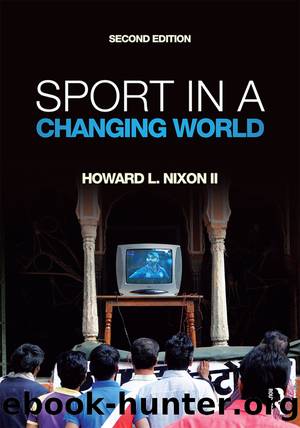Sport in a Changing World by Howard Nixon II

Author:Howard Nixon II [Nixon, Howard II]
Language: eng
Format: epub
ISBN: 9781612058573
Barnesnoble:
Publisher: Taylor & Francis
Published: 2015-07-24T00:00:00+00:00
There are school districts willing and able to spend huge amounts of money on athletics to feed their sports passion, to try to distance themselves from their competitors, and to gain prestige for their community. As in college sports, the âhavesâ in high school sports operate in a very different world of resources and competitive success than the âhave-nots,â who struggle to keep up. At the high school level, poorer communities with more meager tax bases may decide that athletics is a luxury or that those who want their children to participate in sports will have to âpay to play.â Public and corporate support for high school athletics has a limited reach, and the golden triangle does not distribute its largesse evenly across the terrain of high school sports.
In the more privileged stratum of high school sports, there is clear evidence of the golden triangle. Along with the construction of lavish new stadiums, high schools sign deals for naming rights, attract Internet broadcasting revenue, and significantly raise coachesâ salaries (CNBC 2012). In many small towns in the South and Midwest, sports are popular, and high school sports are the major source of local entertainment. In these communities, the market for high school sports has grown and made them more attractive investments for the golden triangle. Local networks and ESPN began covering high school events in the 1980s. When some school districts had to deal with reduced public funding, they sought commercial deals to keep their programs competitive. Taxpayers paid for a new football stadium in Allen, Texas, but the shoe company New Balance invested $500,000 in the renovation of the high school football stadium in Gloucester, Massachusetts. Local businesses have made similar types of investments in other communities across the country. In addition, school districts have been negotiating increasingly lucrative broadcasting rights contracts. For example, the New York City public schools signed a two- year $500,000 deal with MSG Varsity Network. It is part of Cablevision, presents high school content, and concentrates much of its 24/7 programming on high school sports.
Part of the attraction of high school sports to the golden triangle is that three times as many students attend high school as attend college and a large number of high school students are involved in interscholastic athletics, making high school sports a potentially huge market (CNBC 2012). The media and corporate sponsors do not negotiate with a central governance body equivalent to the NCAA at the college level. They instead deal with state- level interscholastic athletic associations in many cases to obtain broadcasting rights and then license them to cable companies, which generate advertising fees to cover their costs. This is the standard formula for generating revenue through the media in the commercialized sports of the golden triangle.
With some television coverage at the national level, we can see why winning and high national rankings have become very important in big- time high school sports. National exposure has also intensified recruiting pressure on top high school athletes (Halley 2013). High
Download
This site does not store any files on its server. We only index and link to content provided by other sites. Please contact the content providers to delete copyright contents if any and email us, we'll remove relevant links or contents immediately.
The Inner Game of Tennis by W. Timothy Gallwey(3479)
Unstoppable by Maria Sharapova(3409)
Urban Outlaw by Magnus Walker(3245)
Crazy Is My Superpower by A.J. Mendez Brooks(3207)
Mind Fuck by Manna Francis(3039)
The Social Psychology of Inequality by Unknown(2770)
The Fight by Norman Mailer(2707)
Unstoppable: My Life So Far by Maria Sharapova(2387)
Accepted by Pat Patterson(2219)
Going Long by Editors of Runner's World(2215)
Futebol by Alex Bellos(2138)
The Happy Runner by David Roche(2125)
Motorcycle Man by Kristen Ashley(2116)
Backpacker the Complete Guide to Backpacking by Backpacker Magazine(2111)
The Sports Gene: Inside the Science of Extraordinary Athletic Performance by David Epstein(2064)
Sea Survival Handbook by Keith Colwell(2044)
Peak: Secrets from the New Science of Expertise by Anders Ericsson & Robert Pool(1927)
Endure by Alex Hutchinson(1873)
The Call of Everest by Conrad Anker(1788)
